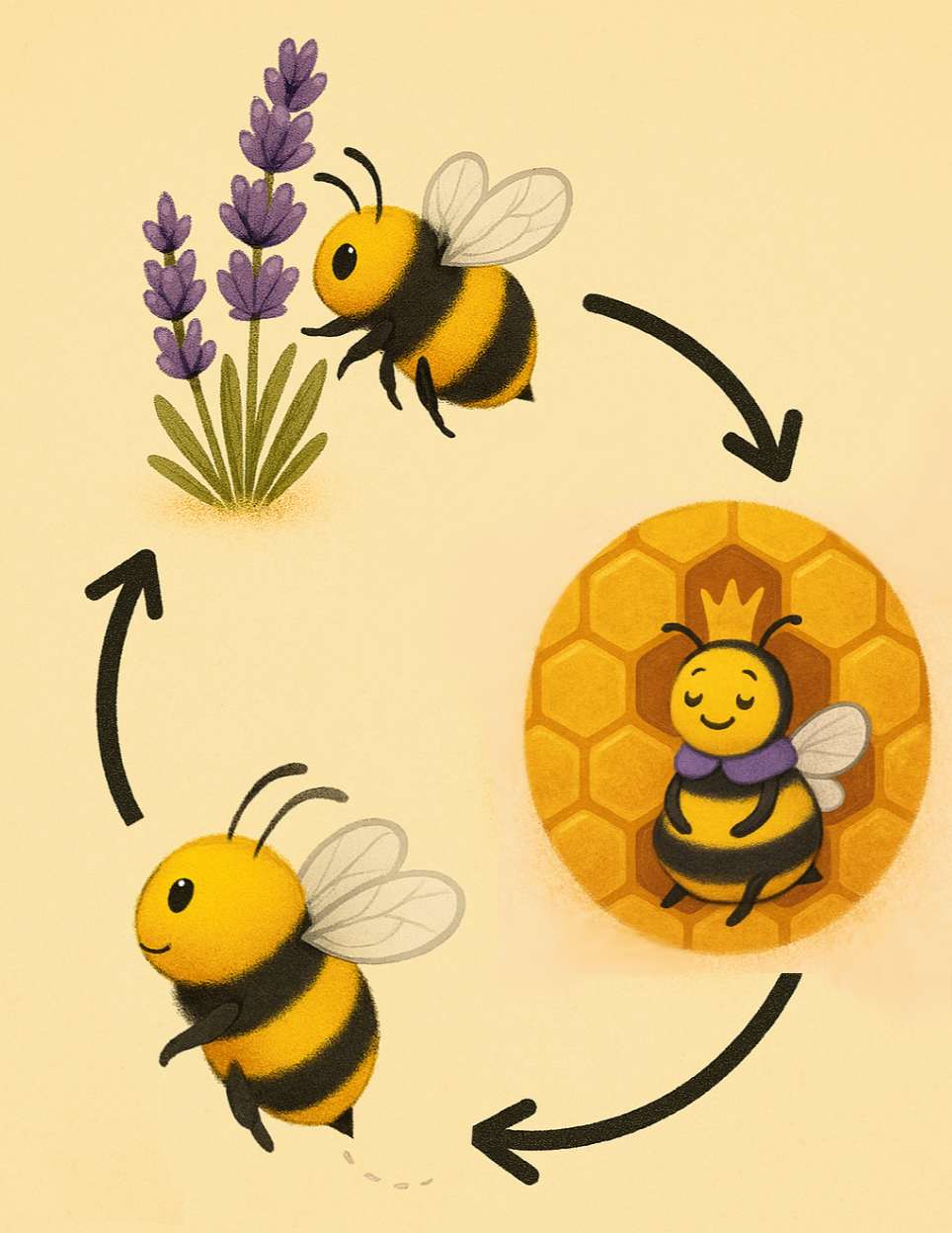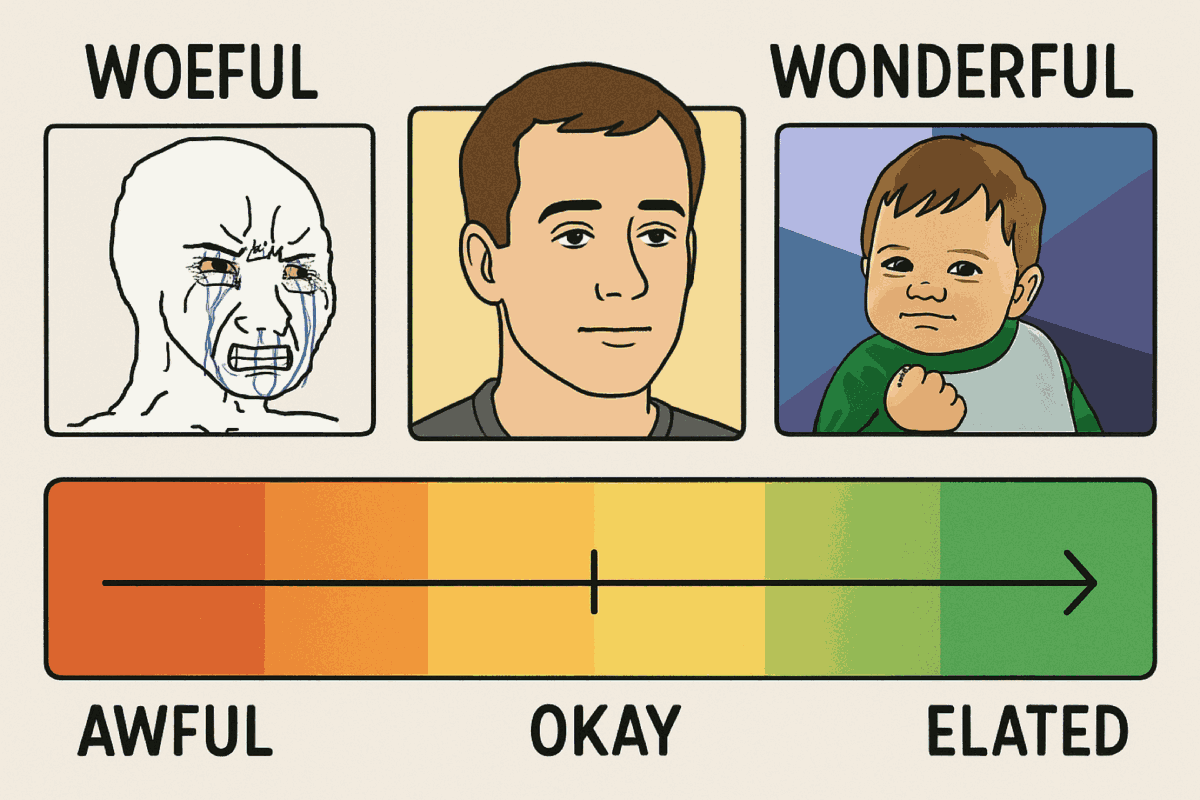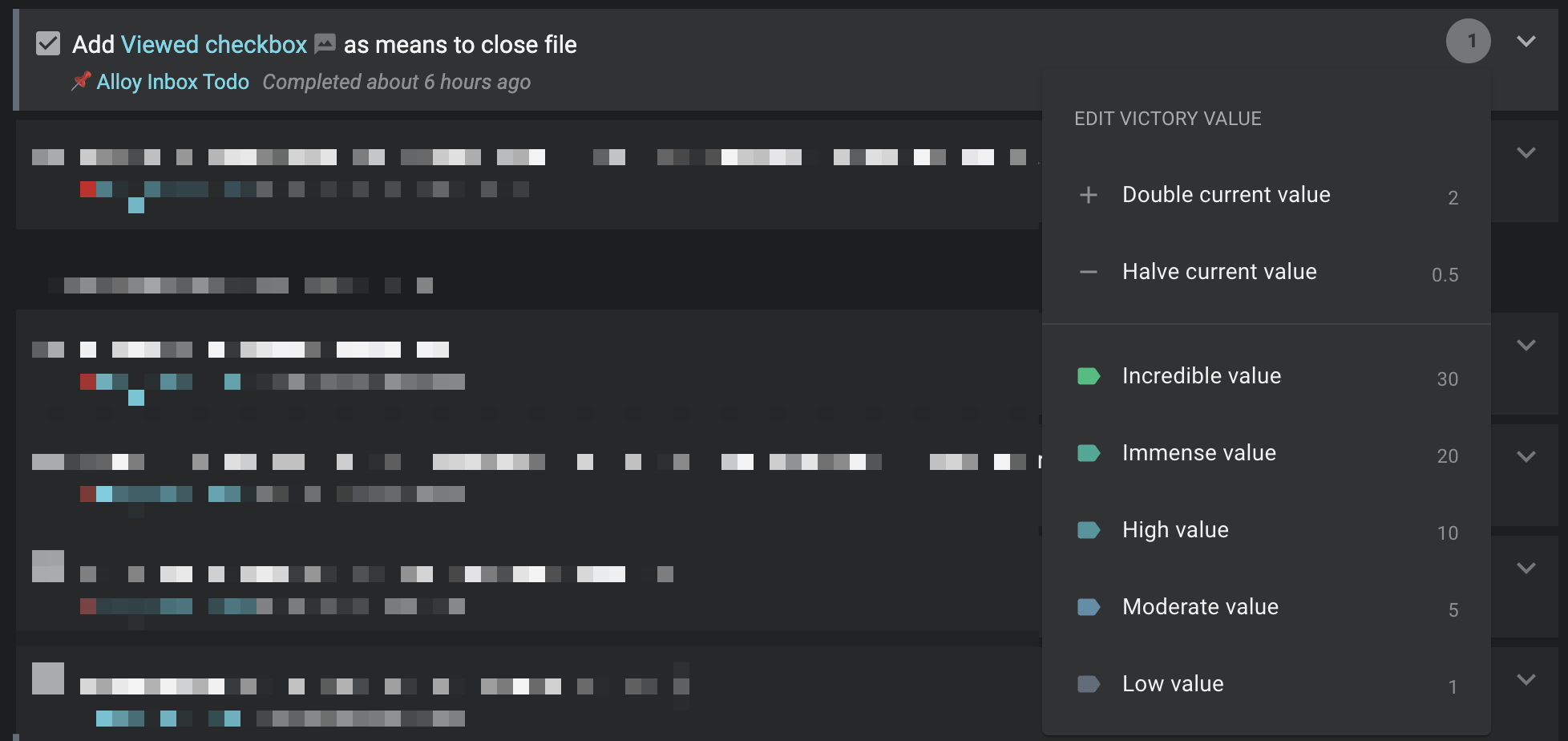Victory Value is designed to quantify how quickly you're progressing toward your ideal life. It exists because "getting things done" is cool, but "being happy while you do it" is cooler.
When you finish a week with high Victory Value, it suggests that you are happier, healthier, wealthier and overall better off than the week before.
The algorithm described on this page was heavily inspired by Ep 361 of the Tim Ferriss podcast with Jim Collins (Good to Great). Their conversation was so resonant that, 6 years later, productivity podcaster Cal Newport still remembered exactly where he had been when he first heard it (Ep 342: The Good Life Algorithm), like this was the moon landing for productivity system tinkerers. We strongly recommend listening to its entirety if you are a fan of Ferriss, Good to Great, Cal Newport, or evergreen productivity strategies in general.
linkThe "Good Life Algorithm," featuring Victory Value
The term "Good Life Algorithm" was coined by Cal Newport (who may or may not be aware Amplenote exists) in episode 342 of his podcast. In his podcast's "Deep Dive" segment, Newport describes how author Jim Collins has designed his life to combine "greater happiness" with "greater productivity," in spite of the latter's tendency to drown out a vibrant life.
Newport explains that, by following the "Good Life Algorithm" inspired by Collins, it's possible to leverage a personal record of daily "tasks completed" and "mood/energy level" into a better life. When you are measuring these data points every day, the historical path you generate can inform the direction of future choices. Extrapolated over years, this approach leads its practitioner to iterate toward more time on the parts of life that have correlated with happiness. Less time on the rest.
Enter Victory Value, our complement to Task Score, built to help you learn from tasks that are done. If you follow the advice of most all productivity systems to periodically stop and think about your past, Victory Value helps to synthesize: among these 100+ finished tasks, which single choice did the most for my long-term well-being?

Do worry, be happy: tracking mood builds willpower to achieve satisfying goals
If you'd like to learn more about what Ferriss, Collins and Newport have to say on this subject, check out the Inspiration for Victory Value section below.
linkVictory Value Components
What data sources does Amplenote use to calculate the Victory Value of a task? To start, every completed task earns one point of Victory Value. Then, look at the following specific factors.
link1. Marked important
Obviously, since "Victory Value" and "Marked Important" are both activated when working on tasks that align with your long-term goals, a task marked "Important" scores more Victory Value.
Specifically, being marked "Important" contributes 7 points to Victory Value.
link2. Longer duration
Tasks that take longer to complete represent more progress than tasks that take less time to complete.
When a duration is set, it contributes Math.max(0, ln(minutes)-1), ideally rounded to the nearest single decimal
So 1-2 minute tasks earn 0 extra value
A 30 minute task gets 2.4
A 60 minute task gets 3.1
A 1 day task (24 * 60 minutes) gets 6.2
There are many ways to set the duration of a task (e.g., dragging it on the calendar), the /duration command is an always-available option.
link3. Enjoyable/satisfying
When mood ratings are submitted in sufficient proximity to a task's completion time, they are factored in to represent that the task seemed to make its executor more or less happy.

Which are ya, and can we upgrade it?
Mood ratings left 0-30 minutes after task completion are multiplied by 2, summed, and added to Victory Value. Consider leaving multiple +2s for an especially satisfying completed task.
Mood ratings left 30-90 minutes after task are summed and added to Victory Value. Example.
All mood ratings for a day will be averaged on the following day. The average of the day's Victory Value ratings will be added to each task.
For example, if the user completed one mood rating of +2, then all the tasks completed that day get +2 Victory Value.
If they completed 3 mood ratings of, -2, -1, +2, that averages to -0.3 points to apply to each task completed on that day
Factoring "mood ratings" into Victory Value helps to tease out what types of tasks bring you joy. It's often impossible to judge which tasks are the most important or satisfying ones when you're in the thick of getting things done. But, as Gillian Welch notes, time's the revelator; when you take a second to leave a rating, it's a breadcrumb for your future self to travel back and crystalize the things you love most.
link4. High leverage
When you find a "lead domino" task -- where completing one task precludes the need to work on other tasks -- a completed task precludes other tasks, we add Victory Value to the completed task that made other tasks obsolete/irrelevant.
If a completed task precludes other tasks with similar/duplicate content, no extra Victory Value is given. In that case, we interpret the linked tasks as mirrors as opposed to "distinct content that was finished by virtue of working on the precluding task."
Assuming the precluded task did have distinct content, the completed task that made it unnecessary will receive a number of points proportional to the tasks that became obsolete
link5. Tag multiplier
When people do monthly/quarterly/yearly planning, as recommended by most of the productivity experts, they will be choosing certain areas they want to prioritize in the coming month/quarter/year.
The Tag Multiplier allows users to incentivize themselves to do more work from the domain that they deemed important, by adding a tag setting for "Victory Value multiplier," available to all Unlimited subscribers.
If a tag is in a context with multiple tags, we'll apply the largest multiplier from among the tags. So, if you've decided that health/fitness is the key to increasing your happiness this quarter, you might apply a 2.0 multiplier to your "fitness" tag. If the task is also an opportunity to socialize (e.g., play a game of football), you might apply a 1.5 multiplier for your "social" tag. When you finish a task from a note tagged with both, its intrinsic Victory Value (based on Importance, duration, etc) is multiplied by 2.0.
link6. Unblocked value
When completing a task unblocks other tasks, that is a victory of sorts. We ascribe 1 point of Victory Value for each task that is unblocked.
linkDismissed Tasks
As with Task Score, dismissed tasks calculate Victory Value and divide it by half. This embodies our philosophical belief that Amplenote should help you let go of the ideas that seemed initially promising, but time has proven you don't really need to do them.
linkManually setting Victory Value
By browsing through your completed tasks, you can click the icon on the right edge of each task to manually assign a value for it, based on your expert judgement of how valuable the task ultimately was.

We encourage customers to periodically revisit past completed tasks that ended up being particularly valuable in retrospect.
linkInspiration for Victory Value, Continued
In depth life-planning from Jim Collins, Tim Ferriss and Cal Newport
The seed for Victory Value was planted by a Tim Ferriss interview with reclusive polymath Jim Collins (author of bestselling, Good to Great). Early in the interview, Ferriss discovers that Collins logs his days to a spreadsheet to optimize how his time will be spent. The sparks of inspiration between the two swell to a fire when Ferriss prompts Collins with "what does a great day look like for you in this daily spreadsheet you keep?"
Collins begins by explaining that "actually, the very best days don't have much in them at all. They are [for example]: Got up early, two hours of really great creative work, breakfast with Joanne, five hours creative work, work out, nap, three hours of creative work, enjoyed dinner with Joanne, bed."
As Collins explains during the 47th minute of the conversation (transcript):
"So I started creating a code, which is +2, +1, 0, -1, -2. The key on all this is you have to do it every day in real time. You can’t five days later look back and say, “How did I feel that day?”
This is a totally subjective 'How quality was the day?' A +2 is a super positive day." More of Jim's thoughts on rating his days.
He then continues, "[tracking mood] has proved to be incredibly useful for me because now what you can do is look, over the last five years, what’s going on in all the +2 days? And over the last five years, what’s going on in the -2 days? And now, as I navigate, it’s kind of like the "Simplex Method" in operations research where you find optimal by never really knowing that optimal is ahead of time. You do it by a series of iterative steps of the next best step." Jim's continued explanation of the benefit he has received.
Amplenote's Completed Task stats let our users elicit the benefits Collins describes. By assessing the historical record of "which tasks did the most to boost my happiness," it becomes possible to gradually incorporate more of them into your daily routine.